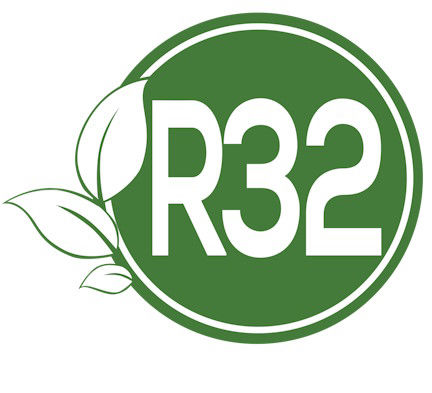What is R32?
R32 is a type of refrigerant gas commonly used in air conditioning systems. It is a hydrofluorocarbon (HFC) with a low global warming potential (GWP) and is considered a more environmentally friendly alternative to older refrigerants such as R22 or R410a.
R32 has a good thermodynamic performance and is flammable, which makes it safe to use by a qualified professional. It is also more energy-efficient than R22 and R410a, which can lead to lower operating costs and reduced carbon emissions. R32 is being increasingly used in residential, commercial, and industrial air conditioning systems as a replacement for R22 and other older refrigerants.
Why does the R32 arrive on the market?
Since the publication of the European F-Gas regulation that prohibited the use of refrigerants with a high global warming potential in 2014, the sector has not stopped innovating technologically to adapt to legal requirements. R410a, which had been used regularly in air conditioning, began to be discontinued once its use ban was announced from the year 2025. A race against time began to be replaced by other gases with less global warming potential.
Differences between R32, R22 and R410A refrigerant gases.
- Global Warming Potential (GWP): R32 has a lower GWP (657) compared to R22 (1810) and R410A (2088). The lower GWP of R32 means it has a lower impact on the environment compared to R22 and R410A.
- Energy efficiency: R32 has a higher energy efficiency compared to R22 and R410A, which means that air conditioning systems using R32 require less energy to operate and can result in lower electricity consumption and cost.
- Flammability: R32 has a lower flammability compared to R22 and R410A, making it a safer option for air conditioning systems.
- Toxicity: R32 is considered to be less toxic compared to R22 and R410A, but it should still be handled with caution to avoid potential harm to humans and the environment.
- Compatibility: R32 is compatible with existing air conditioning systems that use R22 and R410A, making it a suitable alternative for retrofitting existing systems. However, it’s important to consider compatibility with the specific system and components before retrofitting to R32.
- Pressure: R32 operates at a lower pressure compared to R22 and R410A, which can result in smaller and lighter components for air conditioning systems.
- Cost: R32 is generally less expensive compared to R22 and R410A, making it a more cost-effective option for air conditioning systems.
In summary, R32 is a low-GWP, high-energy-efficiency refrigerant that is considered to be a safer alternative to R22 and R410A. The choice of refrigerant will depend on various factors, such as efficiency, safety, cost, and environmental impact, and should be considered on a case-by-case basis.
Ban from 2025 on the use of high GPW refrigerant gas.
The European Union F-Gas Regulation (EU 517/2014) bans the use of hydrofluorocarbons (HFCs) including R410A in new equipment from January 1, 2020, and sets a phasedown of their total quantity placed on the market.
From January 1, 2025, the use of R410A and other high-GWP HFCs will be further restricted in the European Union under the F-Gas Regulation. This includes a ban on the use of these refrigerants in new equipment, as well as limits on their total quantity that can be placed on the market.
In brief, From January 2025, the installation of refrigerant gasses above 750 such as R22 and R410A will be prohibited.
For this reason, with the approval of said regulation, many manufacturers began to work with the R32 refrigerant for residential and semi-industrial applications.
How do I know if my air conditioner uses R32?
There are several ways to determine if your air conditioner uses R32 refrigerant gas:
- Check the manufacturer’s specifications: The manufacturer’s manual or technical specifications for your air conditioner should indicate the type of refrigerant gas used.
- Check the label or nameplate on the air conditioner unit: Some air conditioner units have a label or nameplate that indicates the type of refrigerant used.
- Contact the manufacturer: If you are unable to find the information in the manual or on the unit itself, you can contact the manufacturer for assistance.
- Contact a HVAC professional: If you are still unsure, a heating, ventilation, and air conditioning (HVAC) professional can inspect the air conditioner and determine the type of refrigerant gas used.
It’s important to note that older air conditioners may use R22 or R410A refrigerant gas, which are being phased out due to its high Global Warming Potential (GWP). If your air conditioner uses R22 or R410A , it may be worth considering upgrading to a newer unit that uses a low-GWP refrigerant such as R32.











